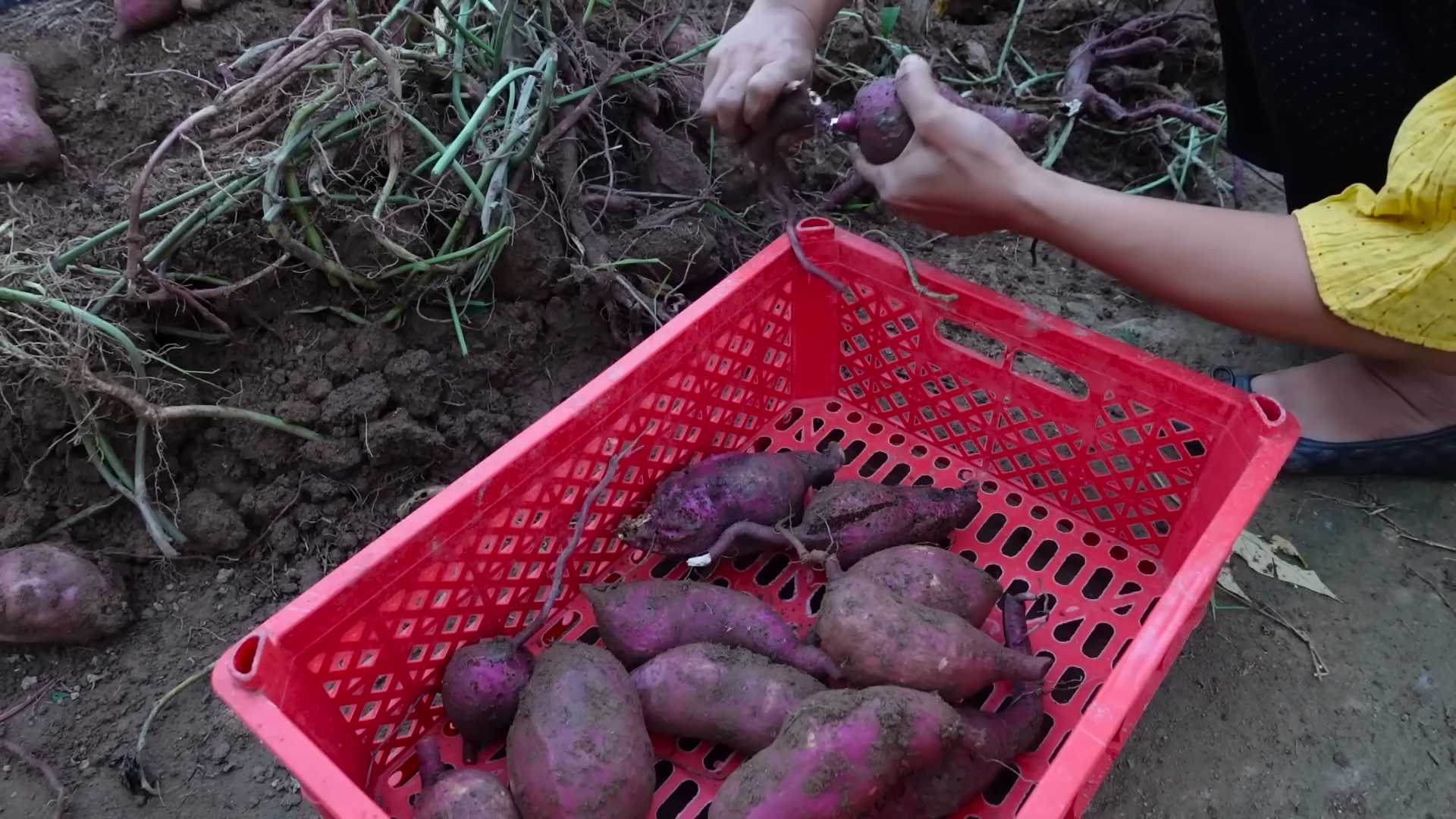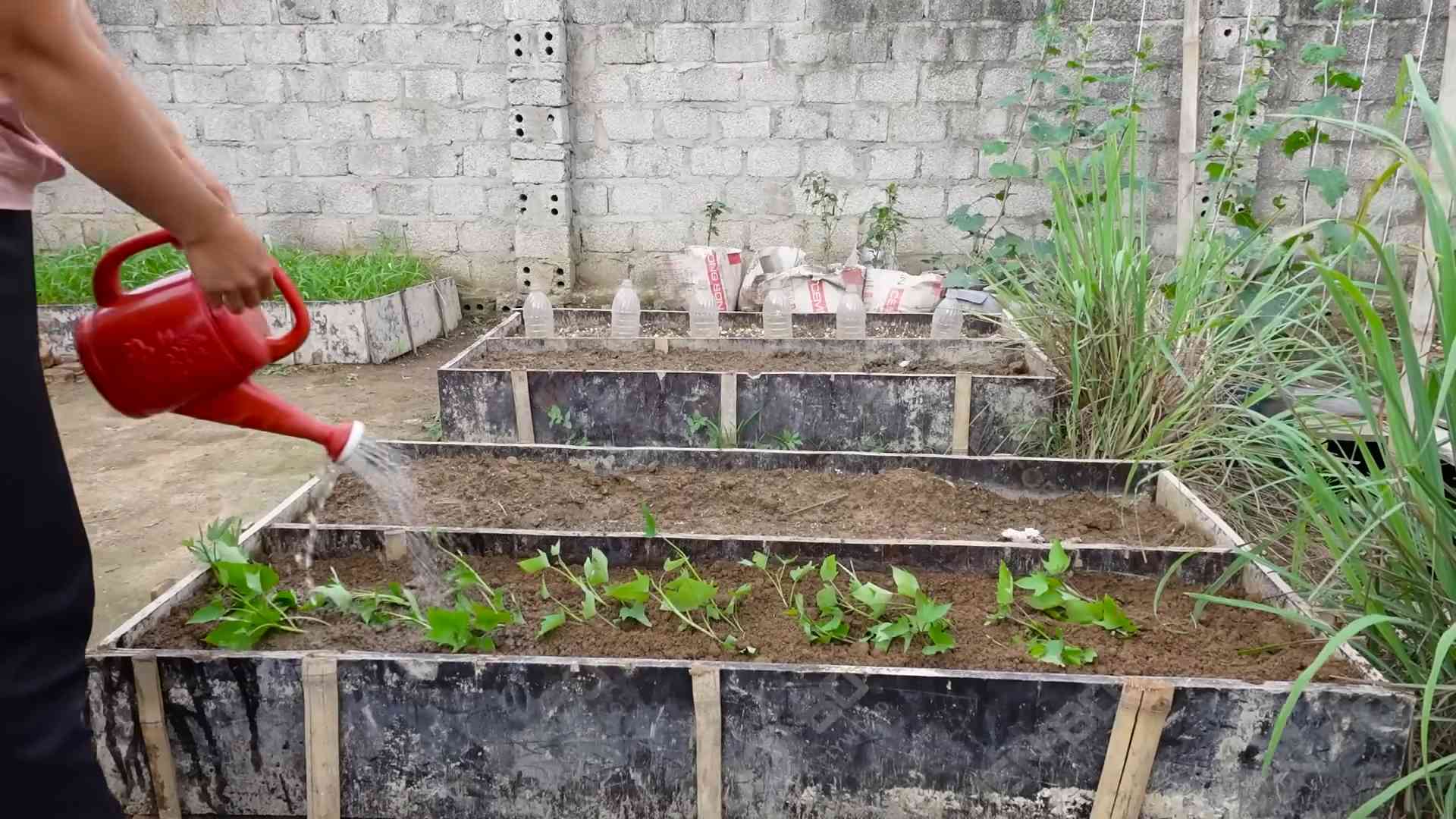Grow Sweet Potatoes at Home – imagine harvesting a bounty of vibrant, earthy sweet potatoes right from your own backyard! Forget those bland, store-bought spuds; we’re diving into the wonderful world of homegrown goodness. For centuries, sweet potatoes have been a staple in diets across the globe, from their origins in Central and South America to becoming a beloved comfort food in countless cultures. Their rich history is as captivating as their flavor!
But why should you bother growing them yourself? Well, for starters, the taste is simply unmatched. Freshly harvested sweet potatoes have a sweetness and depth of flavor that you just can’t find in the supermarket. Plus, you’ll know exactly where your food is coming from and what (or rather, what isn’t) going into it. In this article, I’m going to share some simple, yet effective DIY tricks and hacks that will empower you to grow sweet potatoes at home, even if you have limited space or gardening experience.
Think of it: no more worrying about pesticides or questionable farming practices. Just pure, delicious, homegrown sweet potatoes ready for roasting, mashing, or baking into a delectable pie. So, grab your gardening gloves, and let’s get started on this exciting journey to cultivate your own sweet potato paradise! You’ll be amazed at how easy and rewarding it is.

Grow Your Own Sweet Potatoes: A Beginner’s Guide
Hey there, fellow gardening enthusiasts! I’m so excited to share my experience with growing sweet potatoes at home. It’s surprisingly easy and incredibly rewarding. Nothing beats the taste of a freshly harvested, homegrown sweet potato. This guide will walk you through every step, from sprouting slips to harvesting your delicious bounty. Let’s get started!
Getting Started: Sprouting Sweet Potato Slips
The first step in growing sweet potatoes isn’t planting the potato itself, but rather growing “slips.” Slips are the leafy sprouts that emerge from the sweet potato, and these are what you’ll eventually plant in the ground.
* What are Slips? Slips are essentially sweet potato sprouts. They grow from the “eyes” (similar to potato eyes) on the sweet potato.
* Why Grow Slips? Sweet potatoes are typically grown from slips because planting the whole potato directly in the ground doesn’t always yield the best results. Slips are more reliable and produce healthier plants.
* Timing is Key: Start sprouting your slips about 6-8 weeks before your last expected frost. This will give them plenty of time to develop before planting season.
Step-by-Step Slip Sprouting Instructions:
1. Choose Your Sweet Potatoes: Select organic sweet potatoes from your local grocery store or farmer’s market. Organic is important because non-organic potatoes may be treated to prevent sprouting. Look for firm, healthy potatoes without any soft spots or blemishes. I usually choose 2-3 potatoes to ensure I get enough slips.
2. Prepare Your Sprouting Container: You have two main options here: water sprouting or soil sprouting. I prefer water sprouting because it’s easier to monitor the progress.
* Water Sprouting: You’ll need a glass jar or container that’s wide enough to hold the sweet potato. You’ll also need toothpicks.
* Soil Sprouting: You’ll need a container filled with moist potting soil.
3. Water Sprouting Method:
* Insert Toothpicks: Insert 3-4 toothpicks evenly spaced around the middle of the sweet potato. These will act as supports to suspend the potato in the jar.
* Suspend in Water: Fill the jar with water so that the bottom half of the sweet potato is submerged. The toothpicks should rest on the rim of the jar, holding the potato in place.
* Find a Sunny Spot: Place the jar in a warm, sunny location. A windowsill is ideal.
* Change the Water Regularly: Change the water every 2-3 days to prevent mold and bacteria growth.
* Be Patient: It can take several weeks for slips to start sprouting. Don’t be discouraged if you don’t see anything happening right away. Just keep the water fresh and the potato in a sunny spot.
4. Soil Sprouting Method:
* Bury the Potato: Partially bury the sweet potato in the moist potting soil, leaving the top third exposed.
* Water Regularly: Keep the soil consistently moist, but not soggy.
* Provide Warmth and Light: Place the container in a warm, sunny location.
* Monitor for Slips: Keep an eye out for slips emerging from the soil.
5. Harvesting the Slips: Once the slips are 6-8 inches long, they’re ready to be harvested.
* Gently Twist and Pull: Carefully twist and pull the slips from the sweet potato. Try to get as much of the stem as possible.
* Rooting the Slips: Place the slips in a glass of water, making sure the bottom inch or two of the stem is submerged. Change the water daily. Within a few days, you should see roots starting to develop.
* Alternatively: You can plant the slips directly into moist potting soil. Keep the soil consistently moist until the slips establish roots.
Preparing Your Garden Bed
Now that you have your sweet potato slips rooting, it’s time to prepare your garden bed. Sweet potatoes need plenty of sunshine and well-drained soil.
* Sunlight: Sweet potatoes need at least 6-8 hours of direct sunlight per day.
* Soil: They prefer loose, sandy loam soil that drains well. Heavy clay soil can lead to misshapen potatoes.
* Soil pH: The ideal soil pH for sweet potatoes is between 5.5 and 6.5.
Step-by-Step Garden Bed Preparation Instructions:
1. Choose Your Location: Select a sunny spot in your garden with well-drained soil.
2. Clear the Area: Remove any weeds, rocks, and debris from the area.
3. Amend the Soil: If your soil is heavy clay or lacks nutrients, amend it with compost, well-rotted manure, or other organic matter. This will improve drainage and provide essential nutrients for your sweet potatoes. I usually add a generous amount of compost to my garden bed.
4. Till or Dig: Till or dig the soil to a depth of at least 12 inches. This will loosen the soil and make it easier for the sweet potato roots to grow.
5. Create Ridges or Mounds: Sweet potatoes grow best on ridges or mounds. This helps with drainage and allows the potatoes to expand. Create ridges or mounds that are about 8-12 inches high and 12-18 inches wide. Space the ridges or mounds about 3-4 feet apart.
6. Water the Soil: Water the soil thoroughly before planting.
Planting Your Sweet Potato Slips
Once your garden bed is prepared and your slips have developed roots, it’s time to plant them.
* Timing: Plant your sweet potato slips after the last frost, when the soil has warmed up to at least 60°F (15°C).
* Spacing: Space the slips about 12-18 inches apart on the ridges or mounds.
Step-by-Step Planting Instructions:
1. Dig a Hole: Dig a small hole in the top of the ridge or mound, deep enough to accommodate the roots of the slip.
2. Plant the Slip: Gently place the slip in the hole, making sure the roots are spread out.
3. Cover the Roots: Cover the roots with soil and gently firm the soil around the base of the slip. Leave the top leaves exposed.
4. Water Thoroughly: Water the newly planted slips thoroughly.
5. Mulch (Optional): Mulch around the plants with straw, hay, or other organic mulch. This will help retain moisture, suppress weeds, and regulate soil temperature.
Caring for Your Sweet Potato Plants
Sweet potatoes are relatively low-maintenance plants, but they do require some care to thrive.
* Watering: Water regularly, especially during dry periods. Sweet potatoes need consistent moisture to produce healthy potatoes.
* Weeding: Keep the garden bed free of weeds. Weeds can compete with sweet potatoes for nutrients and water.
* Fertilizing: Sweet potatoes don’t need a lot of fertilizer. In fact, too much nitrogen can lead to excessive vine growth and fewer potatoes. If your soil is poor, you can apply a balanced fertilizer (e.g., 10-10-10) at planting time.
* Pest Control: Sweet potatoes are generally pest-resistant, but they can be susceptible to certain pests, such as sweet potato weevils and flea beetles. Monitor your plants regularly for signs of pests and take appropriate action if necessary.
* Vine Training (Optional): Sweet potato vines can spread quite a bit. If you have limited space, you can train the vines to grow up a trellis or fence.
Tips for Healthy Growth:
* Consistent Watering: Water deeply and regularly, especially during hot, dry weather.
* Weed Control: Keep the area around your sweet potato plants free of weeds.
* Avoid Over-Fertilizing: Too much nitrogen can lead to excessive vine growth and fewer potatoes.
* Monitor for Pests: Check your plants regularly for signs of pests and take action if necessary.
Harvesting Your Sweet Potatoes
The moment you’ve been waiting for! Harvesting your homegrown sweet potatoes is the most rewarding part of the process.
* Timing: Sweet potatoes are typically ready to harvest about 90-120 days after planting. The leaves will start to turn yellow and the vines will begin to die back.
* Weather: Harvest your sweet potatoes on a dry day. Avoid harvesting after a heavy rain, as the potatoes will be more susceptible to rot.
* Before the First Frost: It’s crucial to harvest before the first frost, as frost can damage the potatoes.
Step-by-Step Harvesting Instructions:

Conclusion
So, there you have it! Growing sweet potatoes at home is not only achievable, but it’s also a deeply rewarding experience. Forget those bland, store-bought sweet potatoes that lack character. Imagine sinking your teeth into a vibrant, flavorful sweet potato that you nurtured from sprout to harvest. The difference is truly remarkable.
This DIY trick, transforming a simple sweet potato into a thriving plant, is a must-try for several compelling reasons. First, it’s incredibly cost-effective. Instead of purchasing seedlings, you’re essentially creating your own from a single sweet potato. Second, it’s a fantastic way to connect with nature and witness the miracle of plant growth firsthand. Watching those slips emerge and develop into a sprawling vine is a truly satisfying process. Third, you have complete control over the growing environment, ensuring your sweet potatoes are free from harmful pesticides and chemicals. You know exactly what’s going into your food, and that peace of mind is priceless.
Beyond the basic method, there’s plenty of room for experimentation. Try different varieties of sweet potatoes to discover your favorite flavor profile. Beauregard, Jewel, and Japanese sweet potatoes all offer unique tastes and textures. You can also experiment with different growing mediums. While water works perfectly for sprouting, consider transferring your slips to a raised bed amended with compost for optimal growth. For those with limited space, container gardening is a viable option. Choose a large container (at least 20 gallons) and provide plenty of sunlight and water.
Consider adding companion plants to your sweet potato patch. Basil, thyme, and oregano can help deter pests and improve the overall health of your plants. Marigolds are also a great addition, adding a splash of color and further deterring unwanted insects.
Don’t be intimidated by the process. Even if you’ve never grown anything before, this DIY trick is surprisingly simple and forgiving. The key is patience and consistent care. Keep the water fresh, provide plenty of sunlight, and watch those slips flourish.
We wholeheartedly encourage you to give this DIY trick a try. It’s a fun, educational, and ultimately delicious way to enhance your gardening skills and enjoy the fruits (or rather, roots) of your labor. Once you’ve harvested your first batch of homegrown sweet potatoes, you’ll never look at store-bought ones the same way again.
And most importantly, we want to hear about your experience! Share your photos, tips, and stories in the comments below. Let us know what varieties you tried, what challenges you faced, and what successes you celebrated. Your feedback will not only help other readers but also contribute to a thriving community of home gardeners. Let’s all learn and grow together! This method of growing sweet potatoes at home is a game changer!
Frequently Asked Questions (FAQ)
Q: What kind of sweet potato should I use for sprouting?
A: You can use any variety of sweet potato you find at the grocery store or farmer’s market. However, organic sweet potatoes are generally recommended, as they are less likely to be treated with sprout inhibitors. Beauregard, Jewel, and Japanese sweet potatoes are all popular choices and readily available. Experiment with different varieties to find your favorite!
Q: How long does it take for slips to grow?
A: The time it takes for slips to grow can vary depending on the temperature, humidity, and variety of sweet potato. Generally, you can expect to see slips emerging within 2-4 weeks. Be patient and ensure the sweet potato is kept in a warm, sunny location.
Q: How big should the slips be before I transplant them?
A: The slips should be at least 6-8 inches long before you transplant them. They should also have a good root system developed. Gently pluck the slips from the sweet potato, being careful not to damage the roots.
Q: Can I grow sweet potatoes in containers?
A: Yes, you can absolutely grow sweet potatoes in containers! Choose a large container, at least 20 gallons in size, with good drainage. Fill the container with a well-draining potting mix amended with compost. Provide plenty of sunlight and water regularly. Container-grown sweet potatoes may not produce as large of a harvest as those grown in the ground, but it’s still a great option for those with limited space.
Q: How often should I water my sweet potato plants?
A: Sweet potato plants need consistent moisture, especially during the first few weeks after transplanting. Water deeply whenever the top inch of soil feels dry to the touch. Avoid overwatering, as this can lead to root rot. Once the plants are established, you can reduce watering slightly.
Q: What kind of soil is best for growing sweet potatoes?
A: Sweet potatoes prefer well-draining, sandy loam soil. Avoid heavy clay soils, as they can become waterlogged and hinder root development. Amend your soil with compost or other organic matter to improve drainage and fertility. A slightly acidic soil pH (around 6.0-6.5) is ideal.
Q: How much sunlight do sweet potato plants need?
A: Sweet potato plants need at least 6-8 hours of direct sunlight per day. Choose a sunny location in your garden or on your patio.
Q: What are some common pests and diseases that affect sweet potatoes?
A: Common pests that can affect sweet potatoes include sweet potato weevils, flea beetles, and aphids. Diseases include stem rot, black rot, and scurf. Regularly inspect your plants for signs of pests or diseases and take appropriate action if necessary. Organic pest control methods, such as neem oil or insecticidal soap, can be effective. Crop rotation and using disease-resistant varieties can also help prevent problems.
Q: When is the best time to harvest sweet potatoes?
A: Sweet potatoes are typically ready to harvest about 90-120 days after transplanting. The leaves will start to turn yellow and the vines may begin to die back. To harvest, carefully dig around the plants with a garden fork, being careful not to damage the tubers. Gently lift the sweet potatoes from the soil.
Q: How should I cure sweet potatoes after harvesting?
A: Curing sweet potatoes is essential for developing their sweetness and improving their storage life. After harvesting, gently brush off any excess soil and allow the sweet potatoes to dry in a warm, humid place (around 80-85°F and 85-90% humidity) for 7-10 days. This allows the skins to harden and any minor cuts or bruises to heal. After curing, store the sweet potatoes in a cool, dry, and well-ventilated place (around 55-60°F).
Q: Can I eat the sweet potato leaves?
A: Yes, sweet potato leaves are edible and nutritious! They can be cooked like spinach or other leafy greens. Choose young, tender leaves for the best flavor.
Q: My sweet potato plant is producing flowers. Is this normal?
A: Yes, it is normal for sweet potato plants to produce flowers, although not all varieties do. The flowers are usually small and pink or purple in color. Flowering does not affect the development of the sweet potatoes themselves.
Q: Can I save slips from my sweet potato plants to grow more sweet potatoes next year?
A: Yes, you can save slips from your sweet potato plants to grow more sweet potatoes the following year. Before the first frost, dig up a few healthy sweet potatoes and store them in a cool, dry place. In the spring, you can start the sprouting process again using these stored sweet potatoes. This is a great way to save money and ensure you have a supply of sweet potatoes for years to come.




Leave a Comment